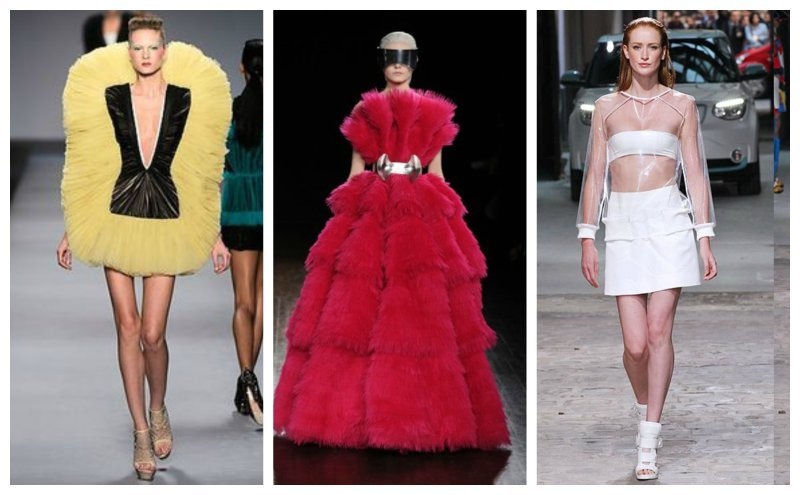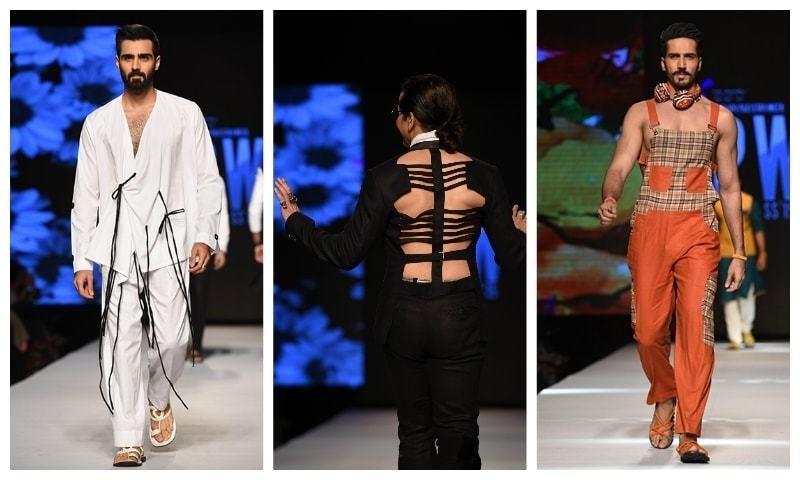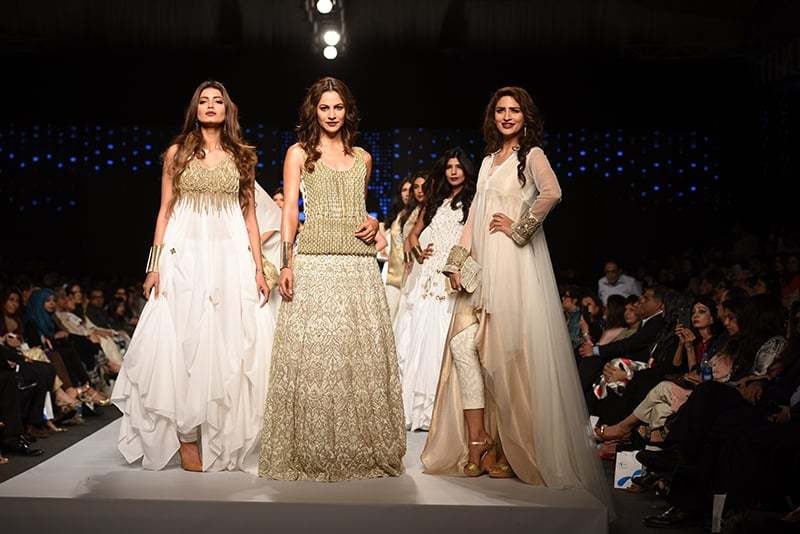This article was actually published here.
As the lights dim and the thumping music begins I prepare myself for the familiar thrill of Fashion Pakistan Week.
The week, for me is always bittersweet. I love fashion and yet so little about FPW is truly about fashion, it's about clothes.
It's about looking pretty rather than making a statement.
It's about showing outfits that will sell rather than fashion that means something.
While I sit a few feet away from what is nothing short of wearable art I can hear jeering and laughing. The well-heeled members of our esteemed fashion fraternity point at the models and crack jokes.
And why? Because what the designer created was not pretty.
But true fashion is about taking a risk and creating something personal - and that does not necessarily mean something pretty. The constant garbled malarkey in the fashion industry of delicate. feminine draping with intricate embellishments has defined a monotone aesthetic that is almost impossible to challenge.

In a way the purpose of fashion is directly at odds with one of the fundamentals of Pakistani culture. While fashion says "push boundaries", our culture has ingrained in to our psyche "don't rock the boat"
In a piece for Dawn style writer Salima Fareesta says of designer Fahad Hussayn:
Fahad sometimes has a tendency to let the drama of his creative vision get the better of him. He is best when he reins in his inner goth a little but didn’t do so this time around.
A reined in fashion show is not art - only clothes. Beautiful clothes, but nothing more.

Taking a risk, making a statement, being different and even being laughed at - much like Day Two's mens wear collection by new designer Abdul Samad is how trends are born.
Disliking Abdul Samad's aesthetic is different from discouraging where that aesthetic is coming from. His undoubtedly unusual menswear collection lacked cohesiveness but was daring in its approach.
Fashion week is a place to embrace the strange and spurn the dull - not the opposite.
When fashion journalist Zurain Imam agreed to wear a custom made jacket by Samad he said he wanted to encourage more eccentricity in the fashion industry.
"Everyone tries to play it safe," he says, "but fashion is about self-expression. It is about having fun. What you show on the catwalk is not supposed to be what you stock at stores - you are supposed to be creative."
But fashion that drives change in clothing, or expresses them – is about giving people what they did not know they wanted. Remaking something that already exists, more of the same will keep Pakistani fashion two steps behind the rest of the world. If you wait for something to be a trend before indulging in it (hello, crop tops) you are no market leader.
How many white on white ball gowns/lehngas/anarkalis have we clapped for over the years?
Yes, those specific pieces may be well constructed but are they interesting? Is it important that they exist in the world?

Seeing a piece of clothing that reflects how you’ve been feeling, in a way you didn’t even articulate to yourself until you saw it, is what compels you to buy something.
That’s why Dior’s New Look, and Armani’s suits, and Chanel’s little tweed jackets, are in museums everywhere. They perfectly defined a time or feeling in a radical new way.
Of course, part of the problem is the economy. The number of designers is increasing, while buying power of customers remains the same. The competition causes most designers to retreat to safety.
Retailers want what "sells".
They forget that what sells today was unfashionable a few years ago. But only taking a risk can result in that unique vision that combines art and style. You have to be willing to fail in order to really succeed.
A old-fashioned aesthete could argue that the role of the artist is to create beauty but life and art messy, ambiguous and complex. The contemporary fashion of modern day Pakistan must reflect the times we live in - the ugliness, the horror and the occasionally bizarre - and help us to see the beauty in it all.
Only then, can museums display local fashion with as much consideration as they do art.
As the lights dim and the thumping music begins I prepare myself for the familiar thrill of Fashion Pakistan Week.
The week, for me is always bittersweet. I love fashion and yet so little about FPW is truly about fashion, it's about clothes.
It's about looking pretty rather than making a statement.
It's about showing outfits that will sell rather than fashion that means something.
While I sit a few feet away from what is nothing short of wearable art I can hear jeering and laughing. The well-heeled members of our esteemed fashion fraternity point at the models and crack jokes.
And why? Because what the designer created was not pretty.
But true fashion is about taking a risk and creating something personal - and that does not necessarily mean something pretty. The constant garbled malarkey in the fashion industry of delicate. feminine draping with intricate embellishments has defined a monotone aesthetic that is almost impossible to challenge.

In a way the purpose of fashion is directly at odds with one of the fundamentals of Pakistani culture. While fashion says "push boundaries", our culture has ingrained in to our psyche "don't rock the boat"
In a piece for Dawn style writer Salima Fareesta says of designer Fahad Hussayn:
Fahad sometimes has a tendency to let the drama of his creative vision get the better of him. He is best when he reins in his inner goth a little but didn’t do so this time around.
A reined in fashion show is not art - only clothes. Beautiful clothes, but nothing more.

Taking a risk, making a statement, being different and even being laughed at - much like Day Two's mens wear collection by new designer Abdul Samad is how trends are born.
Disliking Abdul Samad's aesthetic is different from discouraging where that aesthetic is coming from. His undoubtedly unusual menswear collection lacked cohesiveness but was daring in its approach.
Fashion week is a place to embrace the strange and spurn the dull - not the opposite.
When fashion journalist Zurain Imam agreed to wear a custom made jacket by Samad he said he wanted to encourage more eccentricity in the fashion industry.
"Everyone tries to play it safe," he says, "but fashion is about self-expression. It is about having fun. What you show on the catwalk is not supposed to be what you stock at stores - you are supposed to be creative."
But fashion that drives change in clothing, or expresses them – is about giving people what they did not know they wanted. Remaking something that already exists, more of the same will keep Pakistani fashion two steps behind the rest of the world. If you wait for something to be a trend before indulging in it (hello, crop tops) you are no market leader.
How many white on white ball gowns/lehngas/anarkalis have we clapped for over the years?
Yes, those specific pieces may be well constructed but are they interesting? Is it important that they exist in the world?

Seeing a piece of clothing that reflects how you’ve been feeling, in a way you didn’t even articulate to yourself until you saw it, is what compels you to buy something.
That’s why Dior’s New Look, and Armani’s suits, and Chanel’s little tweed jackets, are in museums everywhere. They perfectly defined a time or feeling in a radical new way.
Of course, part of the problem is the economy. The number of designers is increasing, while buying power of customers remains the same. The competition causes most designers to retreat to safety.
Retailers want what "sells".
They forget that what sells today was unfashionable a few years ago. But only taking a risk can result in that unique vision that combines art and style. You have to be willing to fail in order to really succeed.
A old-fashioned aesthete could argue that the role of the artist is to create beauty but life and art messy, ambiguous and complex. The contemporary fashion of modern day Pakistan must reflect the times we live in - the ugliness, the horror and the occasionally bizarre - and help us to see the beauty in it all.
Only then, can museums display local fashion with as much consideration as they do art.
No comments:
Post a Comment